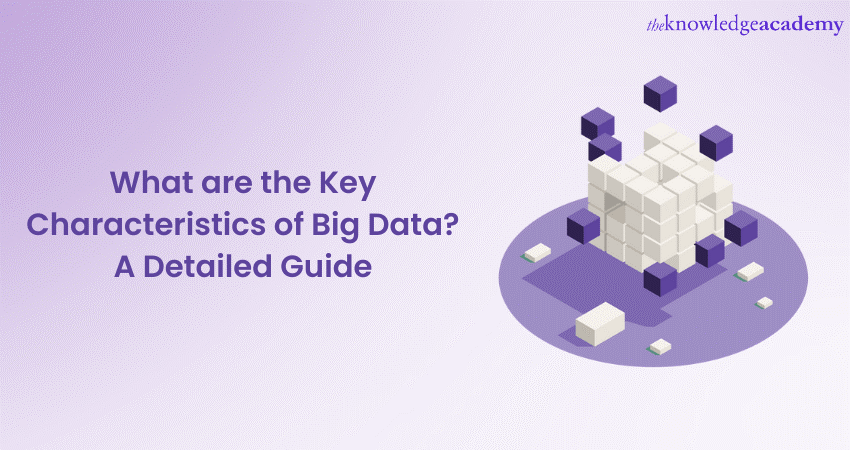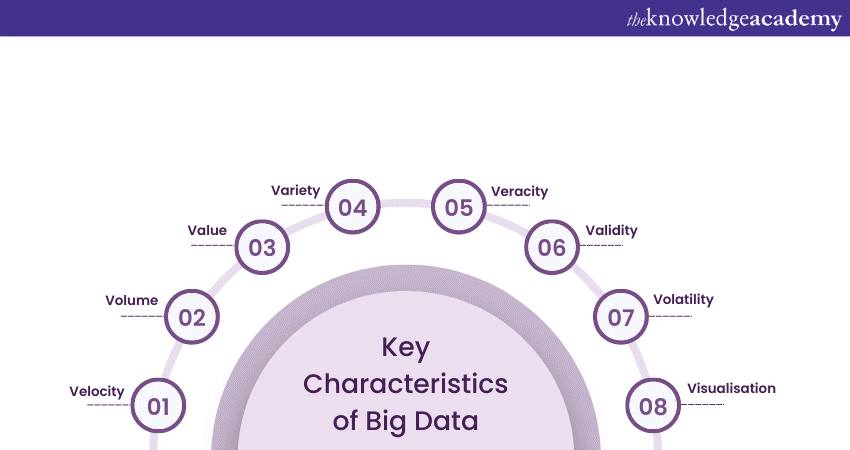We may not have the course you’re looking for. If you enquire or give us a call on 01344203999 and speak to our training experts, we may still be able to help with your training requirements.
Training Outcomes Within Your Budget!
We ensure quality, budget-alignment, and timely delivery by our expert instructors.

Data is an organisation’s most important resource in the modern digital world. Data can be valuable to businesses that can process and harness it with advanced tools for their benefit. Many of the world’s most prominent organisations rely on data to drive operations and enhance profits. However, there is only a particular type of data that organisations can harness. This type of data is commonly known as Big Data and is defined by a number of Characteristics of Big Data.
According to G2, more than 2,500,000,000,000,000,000 bytes (or 2.5 quintillions) of data are created each day. The exponentially growing Big Data market has become an important resource for organisations to harness, and many professionals often ask about the key Characteristics that define Big Data. This blog will tell you all you need to know about the main Characteristics of Big Data, as well as its main components. Read below to find out more!
Table of Contents
1) A brief introduction to Big Data
2) What are the Characteristics of Big Data?
a) Velocity
b) Volume
c) Value
d) Variety
e) Veracity
f) Validity
g) Volatility
h) Visualisation
3) What are the main components of Big Data?
4) Conclusion
A brief introduction to Big Data
Big Data has emerged as a game-changer in the modern era, transforming the way organisations collect, manage, and analyse vast amounts of data. It refers to the huge volume of structured, semi-structured, and unstructured data that inundates businesses and society.
Moreover, Big Data holds immense value, offering insights that can drive innovation, improve decision-making, and fuel growth for the organisation. Harnessing the power of Big Data has become crucial for businesses seeking to stay competitive in the modern digital era. Now, we will move on to exploring the key Characteristics of Big Data analytics, as well as its fundamental components.
Unlock the power of Big Data analysis and elevate your skills with our comprehensive Big Data Analysis Training Course!
What are the characteristics of Big Data?
The key Characteristics of Big Data analytics can be summarised as follows:

Velocity
Velocity is one of the Key Characteristics of Big Data. In the context of Big Data, velocity refers to the speed at which data is generated, processed, and analysed. With the advancement of technology and the increasing interconnectivity of systems, data is generated at an unprecedented rate.
Social media updates, sensor readings, online transactions, and other sources produce a continuous stream of data that requires real-time or near-real-time processing. The ability to handle high-velocity data allows organisations to respond swiftly to changing circumstances and make data-driven decisions in a timely manner.
Volume
Volume is another primary Big Data Characteristics. Volume represents the vast amount of data that is generated and accumulated in the realm of Big Data. The sheer scale of data is massive, often reaching terabytes, petabytes, or even exabytes.
The growth in data volume is attributed to the expansion of digital technologies, such as social media platforms, Internet of Things (IoT) devices, and online transactions. Dealing with such enormous volumes of data necessitates specialised infrastructure, storage systems, and processing capabilities to manage, store, and analyse the data effectively.
Value
The value of Big Data lies in its potential to derive meaningful insights and create value for organisations. By analysing large and diverse datasets, organisations can uncover patterns, correlations, and trends that can lead to valuable insights.
These insights, in turn, can drive informed decision-making, optimise business processes, improve customer experiences, and foster innovation. The value of Big Data lies not only in its quantity but also in the quality of the insights derived from it.
Variety
Variety is the third V when it comes to the Four V’s of Big Data. Big Data comprises various data types, including structured, semi-structured, and unstructured data. Structured data refers to data that is organised and stored in a predefined format, such as databases and spreadsheets.
Semi-structured data has some organisational structure but does not adhere to a strict schema, such as XML or JSON files. Unstructured data, on the other hand, lacks a predefined structure and includes text documents, social media posts, images, videos, and audio files.
Veracity
Variety makes up the four V’s of Big Data Characteristics. Veracity refers to the quality, accuracy, and reliability of the data. Big Data often originates from various sources, and the data may vary in terms of accuracy, completeness, and consistency.
Ensuring data veracity involves addressing data quality issues, performing data cleansing and validation processes, and establishing mechanisms to assess the reliability and trustworthiness of the data. High-quality and reliable data is essential for making sound decisions and drawing meaningful insights from Big Data.
Level up your data science expertise and harness the power of Big Data analytics with our Big Data Analytics & Data Science Integration Course!
Validity
Validity in the context of Big Data pertains to the extent to which the data accurately represents the intended information or concept. It involves assessing whether the collected data aligns with the desired objectives and whether it is relevant and reliable for analysis.
Validity ensures that the data used for analysis is appropriate and fit for the intended purpose, reducing the risk of drawing erroneous conclusions or making flawed decisions based on inaccurate or irrelevant data.
Volatility
Volatility refers to the rate at which data changes or becomes obsolete. Big Data is often characterised by its dynamic nature, with data continuously updated, modified, or replaced. It is important for organisations to stay up to date with the latest data and adapt their analysis processes accordingly.
Managing data volatility involves implementing strategies to capture and integrate new data, handle data updates in a timely manner, and address the challenges associated with data that may quickly become outdated.
Visualisation
Visualisation plays an important role in Big Data analysis. It involves representing data in a visual format, such as charts, graphs, maps, or interactive dashboards. Visualising Big Data allows analysts and decision-makers to comprehend complex patterns, relationships, and trends more easily.
Organisations can effectively communicate insights and findings to a broader audience by presenting data visually. This facilitates understanding and enables stakeholders to make informed decisions based on the visualised information.

What are the main components of Big Data?
The following section of the blog will expand on the main components of Big Data:
Ingestion
Ingestion is a fundamental component of Big Data that involves the process of collecting and acquiring data from various sources. It encompasses the mechanisms and techniques used to capture data and bring it into the Big Data infrastructure for further processing and analysis.
Ingestion can involve real-time streaming of data, batch processing of data in regular intervals, or a combination of both. It includes activities such as data extraction, data cleansing, and data transformation to ensure that the acquired data is accurate and usable for subsequent stages.
Storage
Storage is a critical component of Big Data infrastructure that involves the storage and management of vast amounts of data. Given the enormous volume of data generated in the Big Data ecosystem, traditional storage systems may not be capable of handling the scale and complexity of the data.
Big Data storage solutions often utilise distributed file systems or NoSQL databases that provide scalability, fault tolerance, and efficient data retrieval. These storage systems are designed to handle the velocity, volume, and variety of Big Data while ensuring data integrity and durability.
Analysis
An analysis is a core component of Big Data that focuses on extracting meaningful insights and valuable information from the data. It involves applying various techniques to uncover patterns, trends, correlations, and other valuable information hidden within the data.
Big Data analysis encompasses descriptive, diagnostic, predictive, and prescriptive analytics approaches. Descriptive analytics helps in understanding what has happened in the past. Diagnostic analytics explores why it happened, predictive analytics forecasts future outcomes, and prescriptive analytics suggests actions to optimise results.
Consumption
Consumption refers to the utilisation of the analysed Big Data insights to derive value and make informed decisions. The consumption stage involves the presentation and dissemination of the analysed data and insights to relevant stakeholders. This can include generating reports, creating visualisations, building interactive dashboards, and developing data-driven applications.
By consuming the analysed data, organisations can gain actionable insights that can drive strategic decisions, operational improvements, targeted marketing campaigns, customer personalisation, and other value-adding initiatives.
Conclusion
All in all, Big Data represents a paradigm shift in how organisations collect, manage, and analyse data. The key Characteristics of Big Data, including volume, velocity, variety, veracity, value, and complexity, present both challenges and opportunities. With the power of Big Data, organisations can gain valuable insights, drive innovation, and gain a competitive edge over their industry counterparts.
Take your data analysis skills to new heights with our cutting-edge Big Data and Analytics Training Courses!
Frequently Asked Questions
Upcoming Data, Analytics & AI Resources Batches & Dates
Date
 Hadoop Big Data Certification
Hadoop Big Data Certification
Thu 12th Sep 2024
Thu 12th Dec 2024







 Top Rated Course
Top Rated Course


 If you wish to make any changes to your course, please
If you wish to make any changes to your course, please


